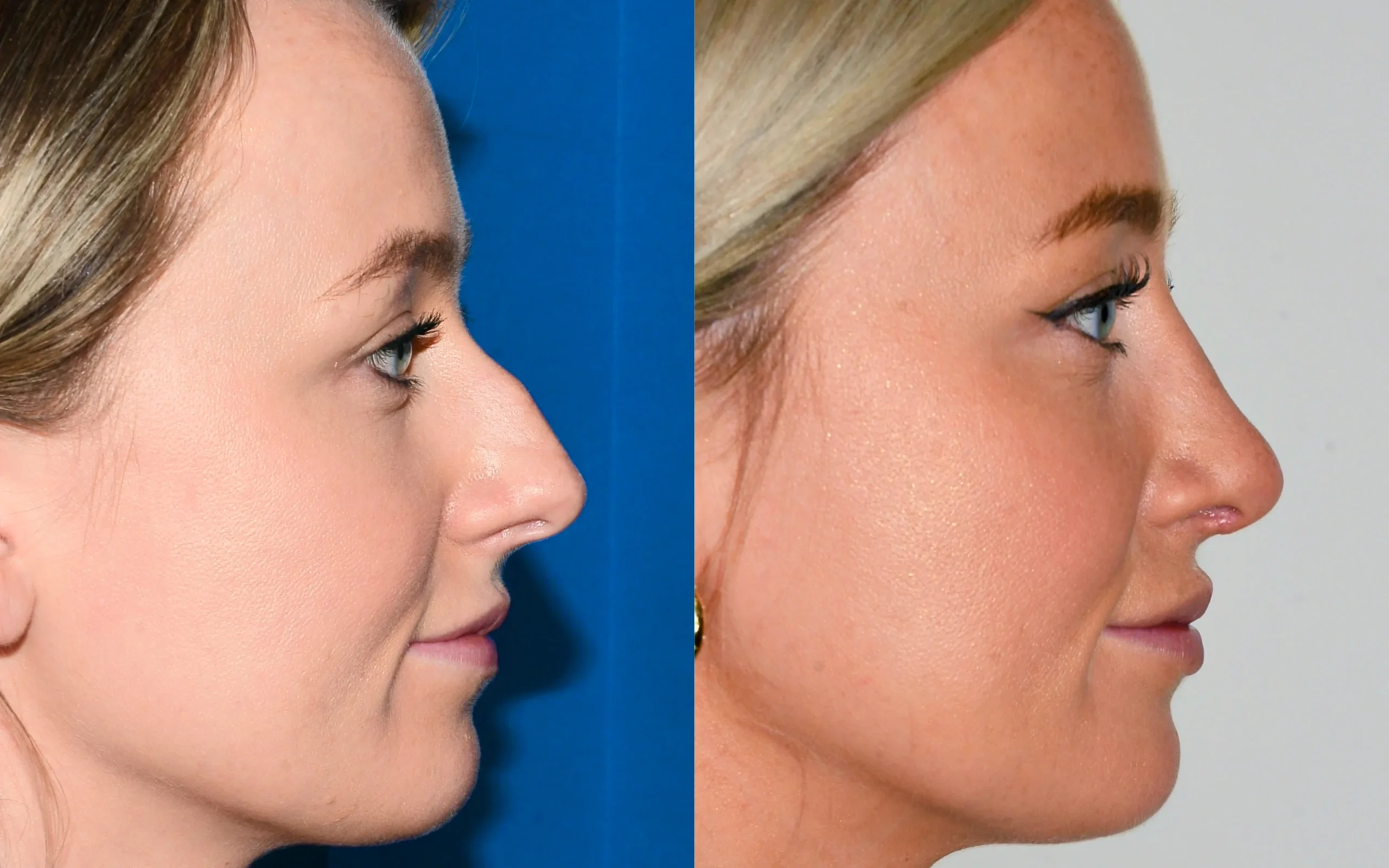Understanding Rhinoplasty: More Than Just a Cosmetic Procedure
Rhinoplasty, commonly referred to as a “nose job,” ranks among the most sophisticated and transformative facial plastic surgery procedures available today. At Facial Surgical Center, rhinoplasty represents the perfect blend of artistic vision and surgical precision. This intricate procedure can dramatically enhance facial harmony while addressing functional concerns that may impact breathing and quality of life.
The nose stands as the central feature of your face, having a nose job is a procedure that can profoundly impact your overall appearance. Whether you’re considering it for cosmetic enhancement or to address breathing difficulties, understanding the nuances of this procedure is essential for making informed decisions about your care.
The Evolution of Rhinoplasty: From Ancient Techniques to Modern Precision
The history of rhinoplasty dates back thousands of years, with early techniques documented in ancient Egyptian and Indian texts. The term “rhinoplasty” derives from the Greek words “rhinos” (nose) and “plassein” (to shape), perfectly describing this transformative procedure. Modern rhinoplasty has evolved dramatically, incorporating advanced techniques and technologies that allow for unprecedented precision and natural-looking results.
Today’s nose job procedures bear little resemblance to their historical counterparts. Contemporary surgeons employ sophisticated three-dimensional imaging, custom-tailored
surgical plans, and refined techniques that minimize recovery time while maximizing results. This evolution has transformed it from a purely cosmetic procedure to a comprehensive approach that addresses both aesthetic concerns and functional issues.
When to Consider Rhinoplasty: Addressing Both Form and Function
Aesthetic Motivations:
- Reducing or increasing nose size to achieve better facial balance
- Modifying the bridge or tip of the nose
- Narrowing the span of the nostrils
- Changing the angle between the nose and upper lip
- Correcting asymmetry or deformities
Functional Reasons:
- Improving breathing difficulties caused by a deviated septum
- Repairing structural damage from trauma or injury
- Addressing congenital defects affecting nasal function
- Correcting previous rhinoplasty complications
- Alleviating chronic sinus issues related to nasal structure
Many patients discover that rhinoplasty can simultaneously address both aesthetic and functional concerns, creating a comprehensive solution that enhances both appearance and quality of life. Modern nose job techniques allow surgeons to create subtle changes that respect your unique facial features while correcting structural issues that may impair breathing or cause discomfort.
The Rhinoplasty Consultation: Your First Step Toward Transformation
The journey toward rhinoplasty begins with a comprehensive consultation. During this crucial appointment, your surgeon will:
- Evaluate your facial structure and nasal anatomy
- Discuss your aesthetic goals and functional concerns
- Review your medical history and previous nasal surgeries
- Examine your nasal passages to identify any breathing issues
- Use digital imaging to simulate potential outcomes
- Explain the surgery’s techniques best suited to your unique situation
- Outline realistic expectations for your nose job results
The consultation serves as an educational opportunity, allowing you to gain insight into the surgery process and establish clear communication with your surgeon. This foundation of understanding and trust is essential for achieving optimal rhinoplasty results. Ready to take the next step? Book your personalized consultation appointment today and begin your journey with confidence.
Types of Rhinoplasty Procedures: Customized Approaches for Individual Needs
Open vs. Closed
The distinction between open and closed rhinoplasty techniques relates to the surgical approach:
- Open Rhinoplasty: Involves a small external incision between the nostrils, providing complete visibility of the nasal structures. This approach is typically preferred for complex cases requiring extensive modification.
- Closed Rhinoplasty: Performed entirely through incisions inside the nostrils, leaving no visible external scars. This technique may be suitable for more straightforward procedures with limited structural changes.
Specialized Procedures
Beyond the standard approaches, specialized techniques address specific concerns:
- Septorhinoplasty: Combines aesthetic rhinoplasty with correction of a deviated septum to improve both appearance and breathing function.
- Revision Rhinoplasty: Addresses complications or unsatisfactory results from previous surgeries, often requiring advanced techniques to work with scarred or altered tissues.
- Ethnic Rhinoplasty: Focuses on preserving ethnic characteristics while making refinements, respecting cultural identity and facial harmony.
- Tip Plasty: Concentrates specifically on refining the nasal tip without altering other aspects of the nose.
- Reduction Rhinoplasty: Focuses on decreasing the overall size of the nose or specific prominent features.
- Augmentation Rhinoplasty: Builds up the nasal structure, often using cartilage grafts to enhance definition or projection.
Each procedure approach offers distinct advantages, and your surgeon will recommend the most appropriate technique based on your anatomy, goals, and recovery considerations.
The Rhinoplasty Procedure: What to Expect During Surgery
Understanding the rhinoplasty procedure can help alleviate anxiety and prepare you for the surgical experience. While specific techniques vary based on your individual needs, most procedures follow a similar sequence:
- Anesthesia Administration: Depending on the complexity of your rhinoplasty, either local anesthesia with sedation or general anesthesia will be administered to ensure your comfort throughout the procedure.
- Incision Placement: Your surgeon will make incisions either inside the nostrils (closed) or across the narrow strip of tissue between the nostrils (open).
- Access to Nasal Structure: Through these incisions, your surgeon will gently raise the soft tissues covering the nose, gaining access to the underlying bone and cartilage.
- Reshaping Process: The bone and cartilage framework will be precisely modified according to your pre-operative plan. This may involve:
- Removing excess bone or cartilage to reduce size
- Adding tissue grafts to enhance certain areas
- Straightening the septum to improve breathing
- Refining the nasal tip through cartilage modification
- Narrowing the nasal bones if necessary
- Tissue Repositioning: Once the structural modifications are complete, the nasal skin and tissue are redraped over the new framework.
- Incision Closure: The incisions are closed with fine sutures designed to minimize scarring.
- Placement of Support Materials: External and internal splints may be placed to support the new structure during initial healing.
The entire rhinoplasty procedure typically takes between two and four hours, depending on the complexity of the case. Most patients can return home the same day, though you’ll need someone to drive you due to the effects of anesthesia.
Recovery After Rhinoplasty: The Journey to Your New Appearance
Immediate Post-Rhinoplasty Period (First Week)
- Wearing a nasal splint for approximately one week
- Experiencing moderate swelling and bruising around the eyes and nose
- Using cold compresses to reduce swelling
- Keeping your head elevated, including while sleeping
- Taking prescribed pain medication as needed
- Avoiding strenuous activities and bending over
Early Recovery Phase (Weeks 2-3)
- The external splint and sutures will be removed
- Most visible bruising will fade
- Swelling will begin to subside, though still noticeable
- You may gradually resume light activities
- Breathing through your nose will become easier
Intermediate Recovery (1-3 Months)
- Most swelling will dissipate, though subtle swelling persists
- The nose will continue to refine in appearance
- You can typically resume all normal activities, including moderate exercise
- Your nose may feel somewhat stiff or numb in certain areas
Long-Term Results (3-12 Months)
- Resolution of all residual swelling
- Full refinement of nasal contours
- Complete healing of all tissues
- Stabilization of the final result
It’s important to understand that the final outcome of rhinoplasty emerges gradually. While you’ll notice immediate changes once the splint is removed, subtle refinements continue to develop over months as swelling fully resolves. Patience during this process is essential for appreciating your complete transformation.
Rhinoplasty Results: What Can Realistically Be Achieved
Successful rhinoplasty creates balanced, natural-looking improvements that complement your facial features. Realistic rhinoplasty outcomes include:
- Enhanced facial harmony and proportion
- Improved nasal contours that appear natural, not “operated on”
- Better breathing function if functional issues were addressed
- Correction of specific concerns while maintaining your unique facial character
- Subtle changes that friends and family may not immediately identify as surgical
- Improved self-confidence and satisfaction with your appearance
The most successful results don’t draw attention to the nose itself but rather enhance overall facial aesthetics. Your nose should complement your other features rather than standing out as the focal point of your face.
Financing Your Rhinoplasty: Investment in Self-Confidence
The cost of rhinoplasty varies based on numerous factors, including the procedure’s complexity, the surgeon’s expertise, geographic location, and facility fees. While primarily cosmetic nose job is typically not covered by insurance, procedures addressing functional issues like breathing difficulties may qualify for partial coverage.
Many practices offer financing options to make it more accessible, including:
- Medical financing plans with manageable monthly payments
- Healthcare credit cards specifically designed for medical procedures
- In-house payment plans offered directly by the practice
- Healthcare savings accounts (HSAs) that may be used for qualifying procedures
When evaluating rhinoplasty costs, remember that this investment yields long-term results that can positively impact your confidence and quality of life for decades to come.
Common Questions About Rhinoplasty
Is it painful?
Most patients report discomfort rather than severe pain after the surgery. Prescription pain medication effectively manages any discomfort during the initial recovery days, after which over-the-counter pain relievers are typically sufficient.
Will my nose be packed after the surgery?
Modern rhinoplasty techniques have largely eliminated the need for uncomfortable nasal packing. Many surgeons now use thin silicone splints or dissolving suture materials that provide support without the discomfort associated with traditional packing.
How long until I can see my final results?
While initial changes are visible once splints are removed (typically after one week), the nose continues to refine for up to a year as swelling completely resolves. The majority of swelling dissipates within 2-3 months, revealing approximately 80-90% of your final result.
Will it leave any visible scars?
Closed rhinoplasty leaves no external scars, as all incisions are placed inside the nostrils. Open ones involve a small incision on the columella (the tissue between the nostrils), which typically heals to become nearly imperceptible within months.
Can it improve my breathing?
Absolutely. Many rhinoplasty procedures specifically address functional issues like deviated septum, enlarged turbinate, or nasal valve collapse that impair breathing. Combining aesthetic improvement with functional correction represents an ideal approach.
What age is appropriate for rhinoplasty?
Most surgeons recommend waiting until facial growth is complete—typically around age 16 for girls and 17-18 for boys. However, if it’s to address breathing difficulties it may be appropriate at younger ages in certain cases.
Conclusion: The Transformative Impact of Rhinoplasty
Rhinoplasty stands as one of the most transformative procedures in facial plastic surgery, offering the potential to enhance both appearance and function. Beyond the physical changes, it often provides profound psychological benefits, including improved self-confidence and social comfort.
The decision to pursue it deserves careful consideration and thorough research. By selecting an experienced specialist, establishing clear communication about your goals, and maintaining realistic expectations about the recovery process, you position yourself for a rewarding experience and satisfying outcome.
Whether you’re seeking rhinoplasty to refine a specific feature, correct a functional issue, or enhance overall facial harmony, this sophisticated procedure offers solutions tailored to your unique needs. The journey toward your ideal nose begins with a single step—scheduling a consultation with a qualified specialist who can guide you through this life-changing transformation.


